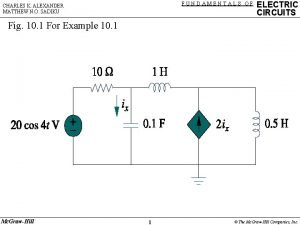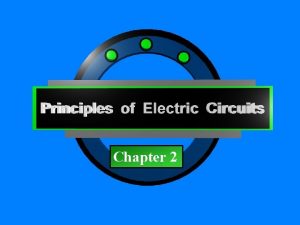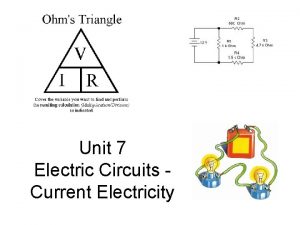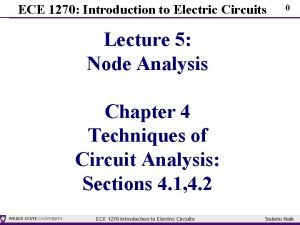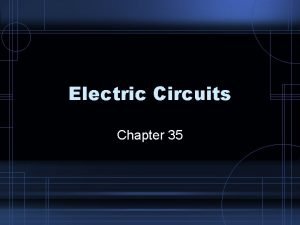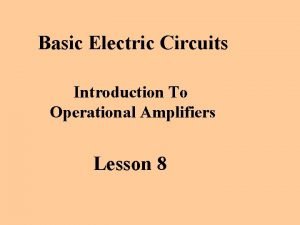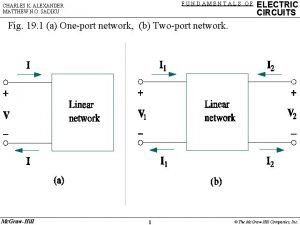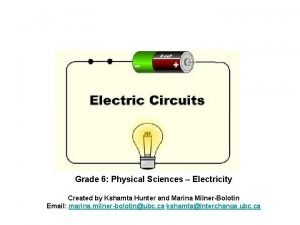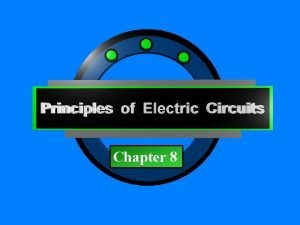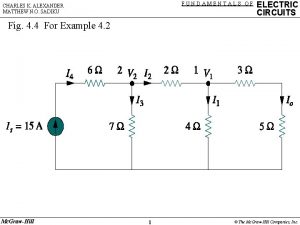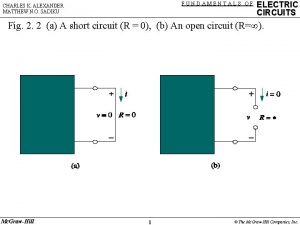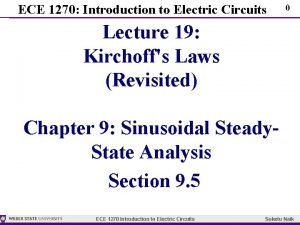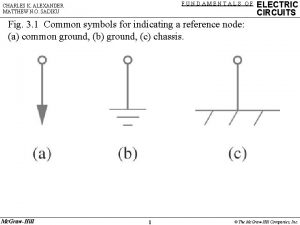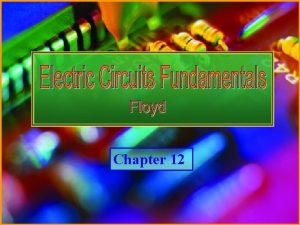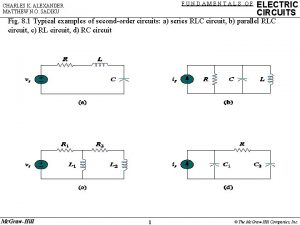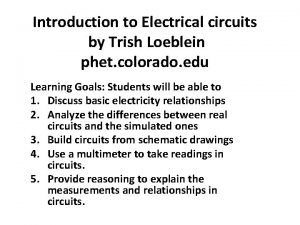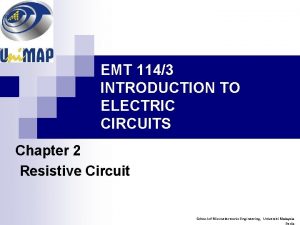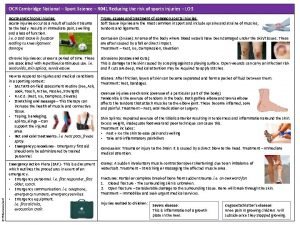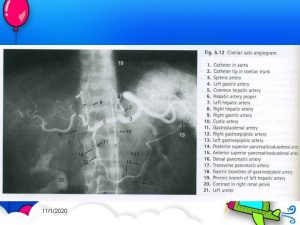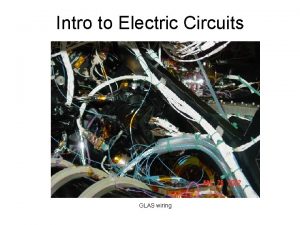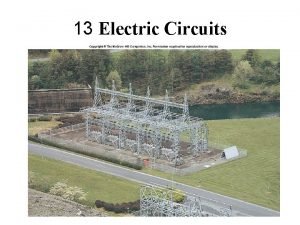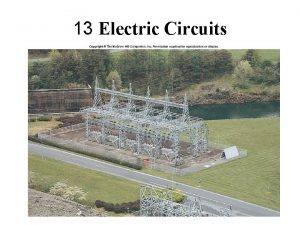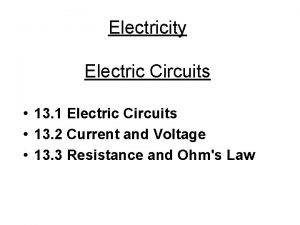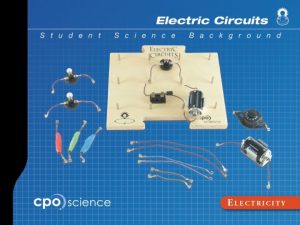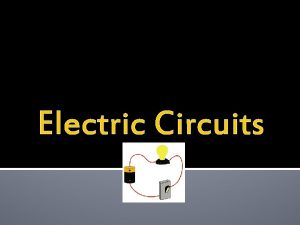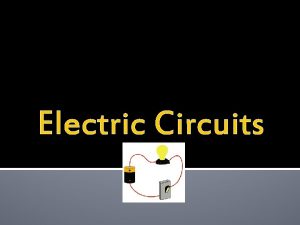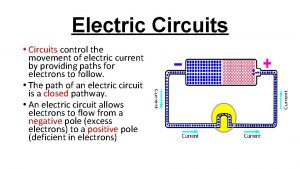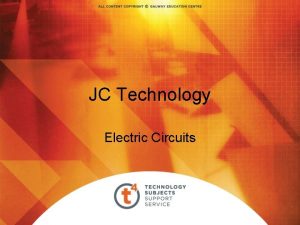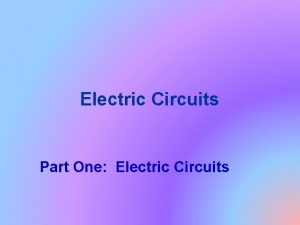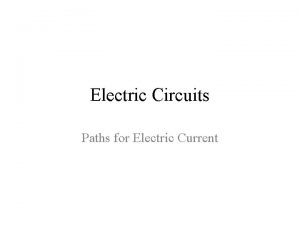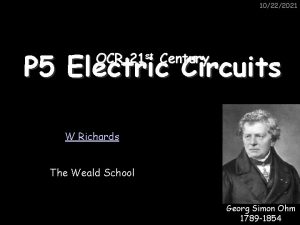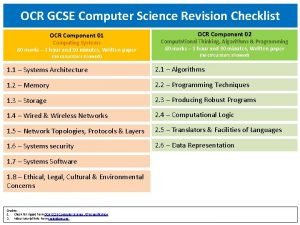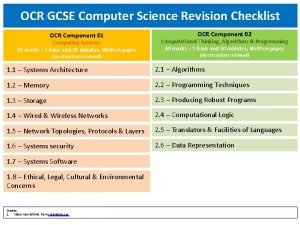01112020 1112020 P 5 Electric Circuits OCR 21
























































- Slides: 56

01/11/2020 11/1/2020 P 5 Electric Circuits OCR 21 st Century Georg Simon Ohm 1789 -1854

11/1/2020 P 5. 1 Electric Current – a Flow of What?

Static Electricity An introduction – click here 01/11/2020 11/1/2020

01/11/2020 11/1/2020 Static Electricity Static electricity is when charge “builds up” on an object and then stays “static”. How the charge builds up depends on what materials are used: - + - + - +

01/11/2020 11/1/2020 Static Electricity + + - - - - -

Short Static Experiments 01/11/2020 11/1/2020 Try the following quick static electricity experiments: 1) Rubbing a balloon on your jumper and “sticking” it to the wall 2) Charging a plastic rod by rubbing it with a cloth and then holding it near the water from a smooth-running tap 3) Charging a plastic rod and trying to pick up small pieces of paper (or someone else’s hair!) with it 4) Rubbing a balloon on someone else’s head – you might want to ask their permission first… Can you explain what you saw in each of these experiments?

Gold Leaf Electroscopes 01/11/2020 11/1/2020 Consider a gold-leaf electroscope… Now charge the top: - - This effect was seen because charges can easily move through conductors

Electric Current Electric current is a flow of negatively charged particles (i. e. electrons). + - e- Note that electrons go from negative to positive By definition, current is “the rate of flow of charge” e- 01/11/2020 11/1/2020

Basic ideas… 01/11/2020 11/1/2020 Electric current is when electrons start to flow around a circuit. We use an _____ to measure it and it is measured in ____. Potential difference (also called _______) is how big the push on the electrons is. We use a ____ to measure it and it is measured in ______, a unit named after Volta. Resistance is anything that resists an electric current. It is measured in _____. Words: volts, amps, ohms, voltage, ammeter, voltmeter

Understanding Current 01/11/2020 11/1/2020 When a voltage is applied it basically causes the electrons in a conductor to move towards the positive end of the battery: Negative Electrons Ions Positive The main difference between conductors and insulators is that insulators have less of these free electrons.

P 5. 2 Current and Energy 11/1/2020

Circuit Symbols 01/11/2020 11/1/2020 Variable resistor Diode Switch Bulb A V Ammeter Voltmeter LDR Resistor Cell Fuse Thermistor Battery

More basic ideas… If a battery is added the current will ____ because there is a greater _____ on the electrons If a bulb is added the current will _______ because there is greater ____ in the circuit 01/11/2020 11/1/2020

Electric Current revisited Work is done by the battery to move the electrons around the circuit. + - e- When the electons arrive at the bulb energy is transferred to it. e- 01/11/2020 11/1/2020 Note that we usually assume the resistance of these leads is very small.

Electrical Power revision 01/11/2020 11/1/2020 Power is defined as “the rate of transferring energy” and is measured in units called “Watts” (W). The amount of power being transferred in an electrical device is given by: Power = voltage x current in W in V in A P V I 1) How much power is transferred by a 230 V fire that runs on a current of 10 A? 2) An electric motor has a power rating of 24 W. If it runs on a 12 V battery what current does it draw? 3) An average light bulb in a home has a power rating of 60 W and works on 230 V. What current does it draw?

Understanding Resistance 01/11/2020 11/1/2020 Recall our previous model of electric current but this time we’ll use it to explain resistance: Negative Electrons Ions Positive Notice that the ions were vibrating and getting in the way of the electrons – this is resistance. This effect causes the metal to heat up.

Using this heating effect 01/11/2020 11/1/2020 This heating effect can have its advantages and its disadvantages. For example, consider an old-fashioned light bulb: This heating effect causes the filament to emit light… …but it also causes a lot of energy to be wasted to the environment

01/11/2020 11/1/2020 Resistance is anything that will RESIST a current. It is measured in Ohms, a unit named after me. Georg Simon Ohm 1789 -1854 The resistance of a component can be calculated using Ohm’s Law: Resistance (in ) = V Voltage (in V) Current (in A) I R

An example question: 01/11/2020 11/1/2020 Ammeter reads 2 A A V Voltmeter reads 10 V 1) What is the resistance across this bulb? 2) Assuming all the bulbs are the same what is the total resistance in this circuit?

01/11/2020 11/1/2020 More examples… 3 A 6 V 12 V 3 A 2 A 4 V 2 V 1 A What is the resistance of these bulbs?

Resistance 01/11/2020 11/1/2020 Resistance is anything that opposes an electric current. Resistance (Ohms, ) = Potential Difference (volts, V) Current (amps, A) What is the resistance of the following: 1) A bulb with a voltage of 3 V and a current of 1 A. 3 2) A resistor with a voltage of 12 V and a current of 3 A 4 3) A diode with a voltage of 240 V and a current of 40 A 6 4) A thermistor with a current of 0. 5 A and a voltage of 10 V 20

LDRs and Thermistors 01/11/2020 11/1/2020

Two simple components: 1) Light dependant resistor – resistance DECREASES when light intensity INCREASES Resistance 01/11/2020 11/1/2020 2) Thermistor – resistance DECREASES when temperature INCREASES Resistance Amount of light Temperature

11/1/2020 Using Thermistors and LDRs in circuits A V 1) What will happen to the resistance of thermistor when it gets hotter? 2) How will this affect the brightness of the bulb and the reading on the ammeter? 3) How will this affect the readings on the ammeter and voltmeter?

11/1/2020 Resistors in Series and Parallel Consider the total resistance of these combinations: 10Ω 10Ω The total resistance of this combination is 20Ω as the battery has to move charges through both resistors The total resistance of this combination is only 5Ω as the charges have more paths to move through

01/11/2020 11/1/2020 Current-voltage graph for a Resistor I V Resistor Notice that a currentvoltage graph for a resistor of fixed value shows that current increases in proportion to voltage.

11/1/2020 P 5. 3 How do Parallel and Series Circuits work?

Current in a series circuit 01/11/2020 11/1/2020 If the current here is 2 amps… The current here will be… And the current here will be… In other words, the current in a series circuit is THE SAME at any point

01/11/2020 11/1/2020 Current in a parallel circuit A PARALLEL circuit is one where the current has a “choice of routes” Here comes the current… Half of the current will go down here (assuming the bulbs are the same)… And the rest will go down here…

01/11/2020 11/1/2020 Current in a parallel circuit If the current here is 6 amps And the current here will be… The current here will be…

Some example questions… 01/11/2020 11/1/2020 3 A 6 A 4 A 2 A 1 A each

Voltage and Work done 11/1/2020 What does “voltage” mean? The voltage (or potential difference) between two points is a measure of the work done per “bit” of charge moving between these points.

Voltage in a series circuit If the voltage across the battery is 6 V… 01/11/2020 11/1/2020 V …and these bulbs are all identical… …what will the voltage across each bulb be? V V 2 V

Voltage in a series circuit 01/11/2020 11/1/2020 V Notice that the voltages add up to the voltage across the battery – this is because the work done on each unit of charge by the battery must equal the work done by it to the bulbs. V V

11/1/2020 What if the Resistances are different? Q. What would each of these voltmeters read? 60 V Total resistance = 30Ω Therefore current = 2 A Therefore V 1 = 2 x 10 = 20 V and V 2 = 2 x 20 = 40 V 10Ω 20Ω V 1 V 2 The voltage across the bigger resistance is higher as more work is done by the battery to get the current through it.

Voltage in a series circuit If the voltage across the battery is 6 V… …what will the voltage across two bulbs be? 01/11/2020 11/1/2020 V V 4 V

01/11/2020 11/1/2020 Voltage in a parallel circuit If the voltage across the batteries is 4 V… What is the voltage here? 4 V V And here? V 4 V

Summary 01/11/2020 11/1/2020 In a SERIES circuit: Current is THE SAME at any point Voltage SPLITS UP over each component In a PARALLEL circuit: Current SPLITS UP down each “strand” Voltage is THE SAME across each”strand”

An example question: 3 A 6 V 3 A A 1 6 V A 2 V 1 2 A 1 A A 3 3 V V 2 01/11/2020 11/1/2020 V 3 3 V

Another example question: 3 A 10 V A 1 1. 2 A 3 A A 2 V 1 6. 7 V A 3 5 V V 2 1. 8 A V 3 5 V 01/11/2020 11/1/2020

11/1/2020 P 5. 4 How is Mains Electricity Produced?

Electromagnetic Induction N The direction of the induced current is reversed if… 1) The wire is moved in the opposite direction 2) The field is reversed The size of the induced current can be increased by: 1) Increasing the speed of movement 2) Increasing the magnet strength 11/1/2020

11/1/2020 Electromagnetic induction The direction of the induced current is reversed if… 1) The magnet is moved in the opposite direction 2) The other pole is inserted first The size of the induced current can be increased by: 1) Increasing the speed of movement 2) Increasing the magnet strength 3) Increasing the number of turns on the coil

Transformers 11/1/2020 Current through primary Time Magnetic field Time Voltage induced in secondary Time

Transformers 11/1/2020 Transformers are used to _____ __ or step down _______. They only work on AC because an ____ current in the primary coil causes a constantly alternating _______. This will “_____” an alternating current in the secondary coil. Words – alternating, magnetic field, induce, step up, voltage We can work out how much a transformer will step up or step down a voltage: Voltage across primary (Vp) No. of turns on primary (Np) Voltage across secondary (Vs) No. of turns on secondary (Ns)

Some transformer questions 11/1/2020 Primary voltage Vp Secondary voltage Vs No. of turns on primary Np No. of turns on secondary Ns Step up or step down? 12 V 24 V 100 ? ? 400 V 20 ? ? 25, 000 V 50, 000 V 1, 000 ? ? 23 V 230 V 150 ? ?

Some example questions 11/1/2020 Primary voltage Vp Secondary voltage Vs No. of turns on primary Np No. of turns on secondary Ns Step up or step down? 6 V 24 V 100 ? ? 400, 000 V 200 V ? 1, 000 ? 25, 000 V ? 20, 000 20 ? ? 230 V 150 1, 500 ? 1) A transformer increases voltage from 10 V to 30 V. What is the ratio of the number of turns on the primary coil to the number of turns on the secondary coil? 2) A step-down transformer has twice as many turns on the primary coil than on the secondary coil. What will be the output (secondary) voltage if the input voltage is 50 V?

AC Generators Magnetic Field 11/1/2020 Slip rings and brushes

Generators (dynamos) 11/1/2020 The coil already has an iron core, but the induced current could still be increased by: 1) Increasing the speed of movement 2) Increasing the magnetic field strength 3) Increasing the number of turns on the coil

01/11/2020 11/1/2020 Large-scale production of Electricity A generator at Drax power station in England

AC Generator N S N 11/1/2020 S Current Induced current can be increased in 4 ways: 1) Increasing the speed of movement 2) Increasing the magnetic field strength 3) Increasing the number of turns on the coil 4) Increasing the area of the coil Time

DC and AC 11/1/2020 V DC stands for “Direct Current” – the current only flows in one direction and a common example is a battery: AC stands for “Alternating Current” – the current changes direction 50 times every second (frequency = 50 Hz). In the UK mains electricity is 230 V AC, not DC, as AC is easier to generate and transmit over long distances. Time 1/50 th s 230 V T V

11/1/2020 P 5. 5 How do Electric Motors work?

The Motor Effect N S 1) What will happen to this wire? 2) How can you make it move faster? 3) How can you make it move in a different direction? 11/1/2020

Electric Motors 11/1/2020

Using Motors 11/1/2020 The following devices are just some examples of devices that use electric motors:
 Bms cdot
Bms cdot Gacepa admin
Gacepa admin Advantages of parallel circuits over series circuit
Advantages of parallel circuits over series circuit Sadiku
Sadiku Principles of electronic circuits
Principles of electronic circuits Chapter 20 electric circuits
Chapter 20 electric circuits Circuit symbols
Circuit symbols Superposition electric circuits
Superposition electric circuits Chapter 35 electric circuits answers
Chapter 35 electric circuits answers Fundamentals of electric circuits chapter 4 solutions
Fundamentals of electric circuits chapter 4 solutions Analogy between electric and magnetic circuits
Analogy between electric and magnetic circuits Find vx
Find vx Chapter 35 electric circuits
Chapter 35 electric circuits Electric circuits equations
Electric circuits equations What are the three elements of electricity
What are the three elements of electricity Fundamentals of electric
Fundamentals of electric Kshamta hunter
Kshamta hunter James w nilsson
James w nilsson Electric current
Electric current Principles of electric circuits 10th edition answer key
Principles of electric circuits 10th edition answer key Charles k. alexander matthew n. o. sadiku
Charles k. alexander matthew n. o. sadiku Fundamentals of electric circuits chapter 9 solutions
Fundamentals of electric circuits chapter 9 solutions Alexander
Alexander Ece
Ece Alexander sadiku
Alexander sadiku Types of circuits and ohm's law worksheet answers
Types of circuits and ohm's law worksheet answers Conceptual physics chapter 35 electric circuits
Conceptual physics chapter 35 electric circuits Electric circuits fundamentals floyd
Electric circuits fundamentals floyd Fundamentals of electric circuits
Fundamentals of electric circuits Fundamentals of electric circuits chapter 7 solutions
Fundamentals of electric circuits chapter 7 solutions Phet build a circuit
Phet build a circuit Quarturs
Quarturs Introduction to electric circuits
Introduction to electric circuits Electric charges and electric forces lesson outline
Electric charges and electric forces lesson outline Electric potential vs electric potential energy
Electric potential vs electric potential energy Chapter 21 electric charge and electric field
Chapter 21 electric charge and electric field Electric field and electric potential
Electric field and electric potential K constant unit
K constant unit Energy electric field equation
Energy electric field equation A suitable electric pump in an electric circuit is a
A suitable electric pump in an electric circuit is a Dc o/d per item charge
Dc o/d per item charge Potential due to a point charge
Potential due to a point charge Chapter 21 electric charge and electric field
Chapter 21 electric charge and electric field Ocr level 6 diploma in career guidance and development
Ocr level 6 diploma in career guidance and development Historical views of mental illness psychology ocr
Historical views of mental illness psychology ocr Ocr past paper mark schemes
Ocr past paper mark schemes Abi ocr software
Abi ocr software Telugu ocr
Telugu ocr Ocr cambridge nationals sports studies resources
Ocr cambridge nationals sports studies resources Ocr j276/01
Ocr j276/01 Gcse speech example
Gcse speech example Sport science ocr
Sport science ocr A level chemistry ocr organic synthesis
A level chemistry ocr organic synthesis Ocr cambridge technicals health and social care
Ocr cambridge technicals health and social care Ocr
Ocr Ocr business level 3
Ocr business level 3 Ocr
Ocr



